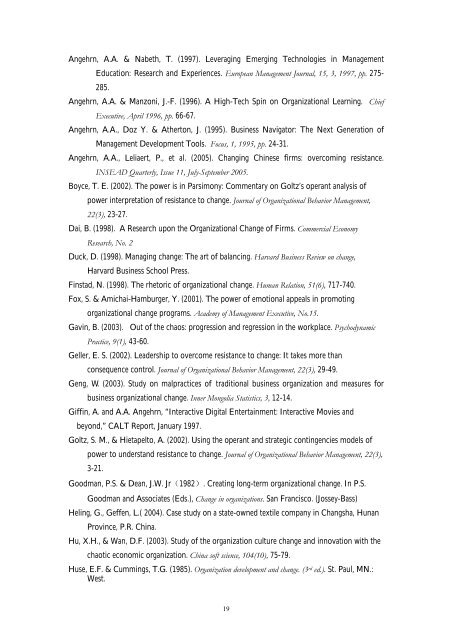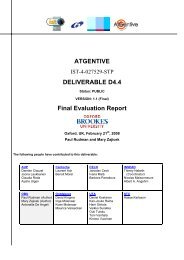LingHe Simulation - INSEAD CALT
LingHe Simulation - INSEAD CALT
LingHe Simulation - INSEAD CALT
You also want an ePaper? Increase the reach of your titles
YUMPU automatically turns print PDFs into web optimized ePapers that Google loves.
Angehrn, A.A. & Nabeth, T. (1997). Leveraging Emerging Technologies in Management<br />
Education: Research and Experiences. European Management Journal, 15, 3, 1997, pp. 275-<br />
285.<br />
Angehrn, A.A. & Manzoni, J.-F. (1996). A High-Tech Spin on Organizational Learning. Chief<br />
Executive, April 1996, pp. 66-67.<br />
Angehrn, A.A., Doz Y. & Atherton, J. (1995). Business Navigator: The Next Generation of<br />
Management Development Tools. Focus, 1, 1995, pp. 24-31.<br />
Angehrn, A.A., Leliaert, P., et al. (2005). Changing Chinese firms: overcoming resistance.<br />
<strong>INSEAD</strong> Quarterly, Issue 11, July-September 2005.<br />
Boyce, T. E. (2002). The power is in Parsimony: Commentary on Goltz’s operant analysis of<br />
power interpretation of resistance to change. Journal of Organizational Behavior Management,<br />
22(3), 23-27.<br />
Dai, B. (1998). A Research upon the Organizational Change of Firms. Commercial Economy<br />
Research, No. 2<br />
Duck, D. (1998). Managing change: The art of balancing. Harvard Business Review on change,<br />
Harvard Business School Press.<br />
Finstad, N. (1998). The rhetoric of organizational change. Human Relation, 51(6), 717-740.<br />
Fox, S. & Amichai-Hamburger, Y. (2001). The power of emotional appeals in promoting<br />
organizational change programs. Academy of Management Executive, No.15.<br />
Gavin, B. (2003). Out of the chaos: progression and regression in the workplace. Psychodynamic<br />
Practice, 9(1), 43-60.<br />
Geller, E. S. (2002). Leadership to overcome resistance to change: It takes more than<br />
consequence control. Journal of Organizational Behavior Management, 22(3), 29-49.<br />
Geng, W. (2003). Study on malpractices of traditional business organization and measures for<br />
business organizational change. Inner Mongolia Statistics, 3, 12-14.<br />
Giffin, A. and A.A. Angehrn, “Interactive Digital Entertainment: Interactive Movies and<br />
beyond,” <strong>CALT</strong> Report, January 1997.<br />
Goltz, S. M., & Hietapelto, A. (2002). Using the operant and strategic contingencies models of<br />
power to understand resistance to change. Journal of Organizational Behavior Management, 22(3),<br />
3-21.<br />
Goodman, P.S. & Dean, J.W. Jr(1982). Creating long-term organizational change. In P.S.<br />
Goodman and Associates (Eds.), Change in organizations. San Francisco. (Jossey-Bass)<br />
Heling, G., Geffen, L.( 2004). Case study on a state-owned textile company in Changsha, Hunan<br />
Province, P.R. China.<br />
Hu, X.H., & Wan, D.F. (2003). Study of the organization culture change and innovation with the<br />
chaotic economic organization. China soft science, 104(10), 75-79.<br />
Huse, E.F. & Cummings, T.G. (1985). Organization development and change. (3 rd ed.). St. Paul, MN.:<br />
West.<br />
19
















